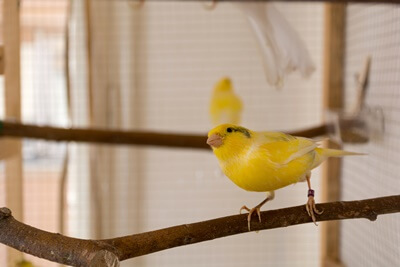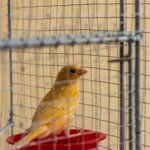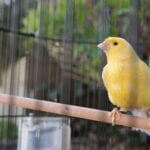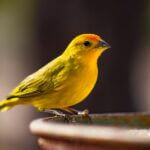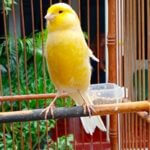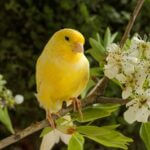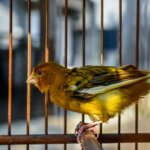Birds use vocalizations to communicate, so you can learn a lot about the message the canary is attempting to convey by learning the different sounds it makes.
Canaries produce the following sounds: warbling, chattering, chirping, squeaking, singing, and shrilling. Besides squeaking, these sounds indicate happiness, and squeaking can mean fighting.
The sounds you hear from a canary depend on the canary’s gender, breed, and age.
Many sounds that canaries make appear similar, but it becomes easier to understand their meaning if you pair them with body language.
What Sounds Do Canaries Make?
Canaries make various sounds, including chirps, shrills, and warbles.
The sounds you’ll hear from a canary depend on the following factors:
Gender
Canaries make different sounds based on their gender.
According to Johns Hopkins University, male canaries have a bigger telencephalic nucleus than female canaries. This is the part of the brain responsible for producing songs and is why male canaries produce a more varied range of vocalizations.
Male canaries can sing, shrill, chirp, and warble. However, female canaries can only chirp, and those who can sing have a limited range or can only sing short songs.
Breed
Each breed specializes in different vocalizations. Here are some examples:
- Waterslager: Prefers to sing with chattering notes that have a choppy, rapid succession.
- American Singer: Produces high-pitched melodic sounds and choppy, chattering sounds.
- Spanish Timbrado: Females can sing, but their songs are shorter, quieter, and tamer than males.
Age
Canaries go through 3 singing phases as they grow up.
The first phase starts at around 3 months. During this time, the canary starts singing for the first time. The singing isn’t good and is primarily soft-spoken chirps and warbles.
Most female canaries stay in this stage of the singing process, while the males move on to the next stage.
After 6 months, the canary will begin to experiment with different sounds. It’ll grow more confident in its singing and become louder.
The last stage begins 8-12 months after the canary’s birth. During this phase, the canary will have mastered its singing, producing the beautiful songs it’s known for.
Seasons
Canaries make different sounds depending on the season.
According to Rockefeller University, the telencephalic nucleus shrinks during molting season. This means that canaries quieten down during the summer. They need to conserve their energy for the molting process, so they sound shy, and their songs are less complex.
Many owners mistakenly believe that their canaries sound sad during the summer. However, just because your canary is quieter during molting season doesn’t mean it’s sad.
A smaller telencephalic nucleus means a limited vocal range and has little effect on canaries’ emotions.
What Do Canary Sounds Mean
Canaries produce six main vocal sounds. They’re capable of producing more, but the average owner wouldn’t be able to distinguish them, given how nuanced they are.
Here are the six common canary sounds:
Chirping
Chirping can be described as short, high-pitched sounds. It sounds melodic and happy. It’s a common sound when waking up in the morning or walking through nature.
It’s a common communication among birds that can produce this sound, meaning the canary is in a good mood.
However, some canaries chirp because it’s the only sound they can make, like female canaries.
When female canaries wish to intimidate another, they’ll chirp because that’s all they can do. It sounds nice, but your female canary is arguing to defend her resources.
That’s why you must look at body language and context when attempting to understand the meaning of canary vocalizations.
Shrilling
Shrilling can be defined as a loud, high-pitched, extended whistling sound.
It’s a sound that can be produced while the canary’s mouth is open or closed. It’s less melodic than chirping and sounds like the canary may be slightly distressed.
However, shrilling isn’t a bad thing. It may sound like panic, but we relate it to certain sounds that crying babies make.
Shrilling is one of many sounds communicating happiness or excitement, like chirping. How often canries mix shrilling with other sounds depends on their breed and whom they learned their songs from.
Squeaking
Squeaking is similar to shrilling in tone, except it’s short and is produced while the mouth is open. However, it isn’t melodic. The squeaks are short and simple and are rarely followed by another sound.
Canaries make this sound while fighting. They’ll squeak at each other while leaning toward their opponent to intimidate them. They’ll open their beak wide as they lean forward and hop around.
To differentiate between a squeak and a chirp, look at the canary’s body language and the context of the situation. If the canary seems defensive and another bird is nearby, it’s probably a squeak.
Warbling
Warbling is when a canary sings in a series of changing notes. It’s a soft noise that sounds like the canary can’t sustain a note as its voice wavers. Still, canaries make it sound beautiful.
Male canaries warble the most in the first 6 months of their lives. After that, they start using other singing techniques that sound more confident and attractive to female canaries.
Females still warble well into adulthood. Sometimes, adult male canaries will warble while molting, and though it sounds weaker than their usual singing, it doesn’t mean they’re in discomfort.
Chattering
Chattering is similar to warbling, but the canary rapidly repeats the same note instead of quickly changing between notes. Chattering sounds harsh because there’s no melody behind the sounds; it’s repetitive, and canaries chatter loudly.
Like shrilling, chattering doesn’t mean anything and is simply a sound canaries make. American Singers and Yorkshire canaries are well-known for their chattering.
Singing
Canary singing combines all the different sounds a canary can make. It can be classified as a sound of its own because it conveys emotion depending on the context.
It’s difficult to tell how a canary feels from the notes alone since they’re bred to sing a lot, regardless of how they feel. Canary songs can tell you a lot, depending on the volume of the sound.
Loud singing indicates excitement or happiness. You may hear your canary sing almost impatiently during feeding time. Male canaries will sing louder than usual when trying to impress females. It may sound irritating and angry, but this is only because your canary is trying to sound tough.
Quiet singing is a sign of a relaxed, contented canary. Quiet songs are common when the canary is going through a stressful time but is in no immediate danger and is still relatively happy.
Why Doesn’t My Canary Sound Normal?
There’s no need to feel concerned if your canary doesn’t sound like other canaries.
Young canaries spend the first few months of their lives learning how to sing from their fathers. Your canary will make unusual sounds if it has never been around other adult canaries.
According to Science, young, fatherless canaries grow up making strange sounds.
Canaries are fantastic imitators from the moment they’re born, which is how they can learn to sing like adult songbirds. So, a canary that has never learned to sing from an adult canary will still imitate sounds it grows up with. The result is a canary that produces songs that sound nothing like canary songs.
Fortunately, this changes with time. According to that study, when spring arrives and the canary wants to mate, it’ll automatically begin to sound like other canaries.
If your canary sounds odd year-round, there could be something wrong with the canary’s syrinx.
How to Help Your Canary Make Different Sounds
If you want your canary to sing different songs, you must train it properly. Teaching a canary to sing while still young is easier, but adult canaries may sing differently occasionally.
Before you train your canary, consider its breed and what you want from the training sessions.
Certain breeds have more varied sounds than others, such as the Waterslager canary, which can sing in high and low pitches.
The best way to help a canary make different sounds is by playing audio of other singing canaries. Male canaries change their tune when they think another canary is nearby.
If you do this, ensure the singing comes from a female canary. Male canary sounds may stress your bird because it believes a male will threaten it. However, female canary singing will encourage your male canary to serenade differently for a moment.
Besides playing audio, there are other things you can do:
- Keep it well-fed.
- Provide a comfortable and familiar environment.
- Playing music.
- Whistle.
- Keep it entertained.
Sad Canary Sounds
Some of the sounds canaries make sound sad to us, but canaries don’t make sounds when unhappy.
When injured, bored, stressed, or ill, canaries quieten down and stop singing. The quieter they are, the more severe their ailment.
The reason canaries sing when happy but stay quiet when sad is connected to their energy levels. Despite how effortless they make it seem, singing requires energy and concentration.
When canaries have a health condition, they need to focus on recovery. Instead of making sad sounds, they stop vocalizing and rest.

